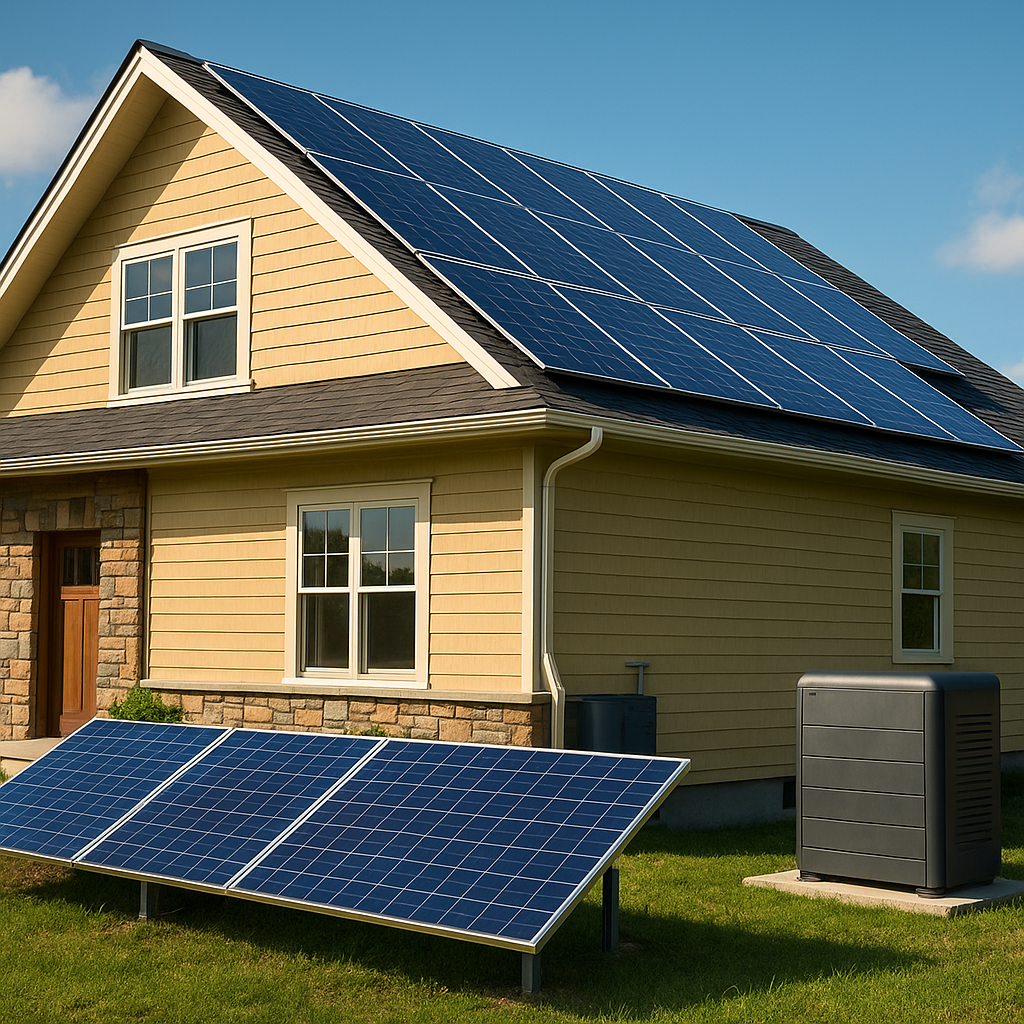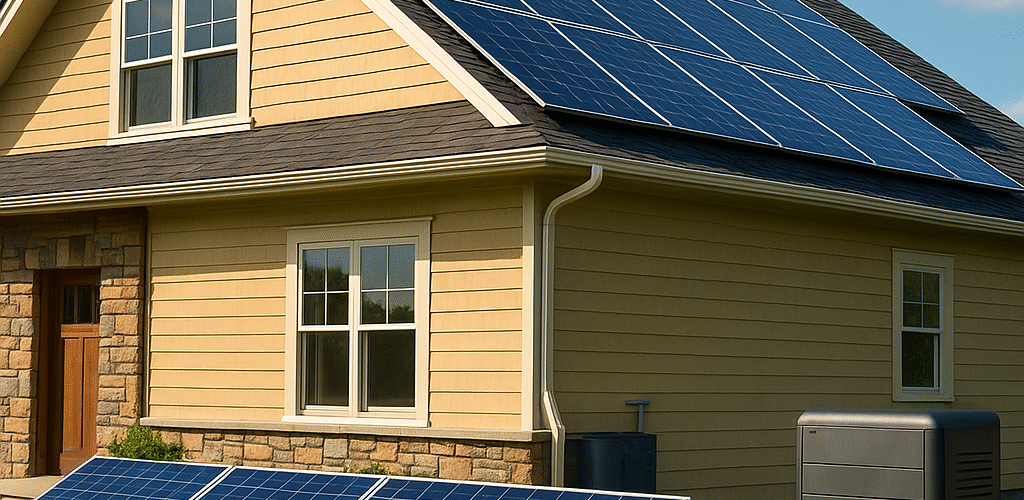
Living in a home powered by solar is no longer a futuristic fantasy. It’s here, it’s real, and it’s transforming how people think about energy. Whether you’re prepping for independence, saving money, or embracing sustainability, solar energy can carry the full load—if you plan it right.
This article will show you how to run your entire home using solar energy, from system design to storage, backup, and beyond. Let’s illuminate your path to energy freedom.
Why Go Fully Solar? The Case for Complete Energy Independence
Going fully solar means powering every appliance, light, and system in your home without relying on the grid.
Why do people choose this path? Three reasons stand out:
- Freedom: No more power outages or utility rate hikes.
- Sustainability: Cut your carbon footprint drastically.
- Savings: After the upfront cost, sunlight is free.
For off-gridders, minimalists, and eco-warriors alike, solar is the ultimate symbol of self-reliance.
If you’re new to this world, explore our Ultimate Guide to Off-Grid Power.
Can Solar Really Power Your Whole Home?
Yes, it absolutely can—but only if your system is properly sized and installed.
The average American home uses around 30 kWh per day. Solar can cover that, but every house is different.
Consider the energy needs of:
- Fridge and freezer
- Lighting
- HVAC systems
- Water pumps
- Electronics and charging stations
A common myth is that solar is only for “tiny homes” or off-grid cabins. In truth, modern solar energy systems can handle entire suburban homes, farms, and more.
Curious about hybrid setups? We dive into that in Solar vs Wind vs Hydro: What’s Best for Your Off-Grid Setup?
Core Components of a Fully Solar-Powered System
To run everything on solar, you’ll need more than just panels. Here’s a basic list:
- Solar Panels: Monocrystalline or polycrystalline, 300W–500W each.
- Inverter: Converts DC (solar) to AC (home use).
- Charge Controller: Manages power flow to batteries.
- Battery Bank: Stores power for night and cloudy days.
- Monitoring System: Tracks generation and usage.
For a deeper look at batteries, see Battery Banks Demystified: The Heart of Off-Grid Power.
Sizing Your System – How Much Solar Do You Really Need?
Let’s do a quick breakdown:
- Find your daily energy usage (in kWh).
- Add a 25–30% buffer for cloudy days and future expansion.
- Divide that by the average sun hours in your area.
- That gives you the kW capacity you need.
Example: If your home uses 30 kWh/day and you get 5 sun hours/day:
30 ÷ 5 = 6 kW solar system (plus buffer = ~8 kW).
Many tools online help with this calculation, but nothing beats getting professional input.
Want to avoid the most common solar sizing mistakes? Read Top 7 Mistakes to Avoid When Setting Up Off-Grid Energy Systems.
Battery Storage – The Key to 24/7 Solar Power
Solar works great when the sun is shining. But what about nighttime or overcast weeks?
That’s where batteries come in. A robust battery bank stores excess energy during the day for use later.
You’ll want:
- Enough capacity to cover at least one full day of use.
- Reliable lithium or AGM batteries.
- A safe, well-ventilated space for installation.
Without batteries, you’re tied to grid-tied solar. With them, you’re truly independent.
Need help deciding which battery fits your lifestyle? Don’t miss our deep dive: Battery Banks Demystified.
Backup and Redundancy – Do You Still Need a Generator?
Even the most optimized solar setups can fall short during long storms or equipment failures.
That’s why backup systems matter:
- Propane or diesel generators are common.
- Some opt for a small wind turbine as supplemental energy.
- Others add a grid-tied hybrid mode for emergencies.
We cover all those combinations in The Ultimate Guide to Off-Grid Power.
What Does It Really Cost to Go Fully Solar?
Costs vary depending on home size, energy needs, and location, but here’s a general range:
- Small home (3–5 kW): $10,000–$20,000
- Mid-size home (6–10 kW): $20,000–$35,000
- Large home (10–20 kW): $35,000–$60,000
These numbers include installation, batteries, and inverters.
While upfront costs can be high, many homeowners break even within 7–10 years.
Looking for affordable options? Check Affordable Off-Grid Energy Solutions for Preppers on a Budget.
Real Homes That Run 100% on Solar
Here are real examples of people living the solar dream:
🌄 Colorado Family Farm
- 12 kW solar array with 30 kWh lithium battery storage.
- Fully off-grid since 2019.
🌿 Urban Smart Home in Austin, TX
- Grid-tied with battery backup.
- Over 95% solar powered year-round.
🏕️ Tiny Home in Oregon
- 3 kW system with AGM batteries.
- Fully self-sufficient including rainwater collection.
Want to build something similar? Check From Zero to Energy Independence.
Planning Your Transition – A Step-by-Step Approach
Going 100% solar doesn’t happen overnight. Here’s a realistic process:
- Audit your energy use. Know what you need.
- Research your options. Solar, batteries, installers.
- Start small. Maybe power just your fridge or workshop first.
- Build in stages. Expand as budget and knowledge grow.
- Embrace the lifestyle. Solar living is also about energy awareness.
Need gear recommendations? Don’t miss 12 Must-Have Tools for Building a Reliable Off-Grid Power System.
More Articles to Supercharge Your Solar Journey
Want to go deeper into the world of off-grid and solar living? Check out these powerful resources from MuseGlobe:
- The Ultimate Guide to Off-Grid Power: Solar, Wind, and Beyond
Your all-in-one blueprint for mastering off-grid energy systems. - 7 Common Off-Grid Energy Mistakes to Avoid
Don’t fall into the traps that cost beginners time and money. - Battery Banks Demystified
Everything you need to know about storing power safely and efficiently. - From Zero to Energy Independence
Learn how real people are achieving total energy freedom—starting from scratch.

